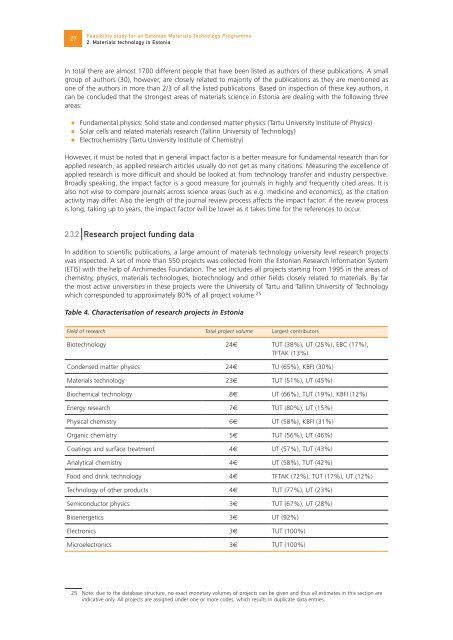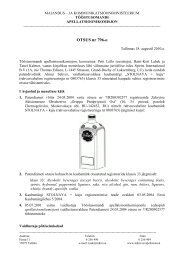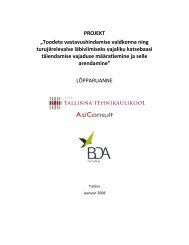Feasibility study for an Estonian Materials Technology Programme
Feasibility study for an Estonian Materials Technology Programme
Feasibility study for an Estonian Materials Technology Programme
Create successful ePaper yourself
Turn your PDF publications into a flip-book with our unique Google optimized e-Paper software.
27<br />
<strong>Feasibility</strong> <strong>study</strong> <strong>for</strong> <strong>an</strong> Estoni<strong>an</strong> <strong>Materials</strong> <strong>Technology</strong> <strong>Programme</strong><br />
2. <strong>Materials</strong> technology in Estonia<br />
In total there are almost 1700 different people that have been listed as authors of these publications. A small<br />
group of authors (30), however, are closely related to majority of the publications as they are mentioned as<br />
one of the authors in more th<strong>an</strong> 2/3 of all the listed publications. Based on inspection of these key authors, it<br />
c<strong>an</strong> be concluded that the strongest areas of materials science in Estonia are dealing with the following three<br />
areas:<br />
Fundamental physics: Solid state <strong>an</strong>d condensed matter physics (Tartu University Institute of Physics)<br />
Solar cells <strong>an</strong>d related materials research (Tallinn University of <strong>Technology</strong>)<br />
Electrochemistry (Tartu University Institute of Chemistry)<br />
However, it must be noted that in general impact factor is a better measure <strong>for</strong> fundamental research th<strong>an</strong> <strong>for</strong><br />
applied research, as applied research articles usually do not get as m<strong>an</strong>y citations. Measuring the excellence of<br />
applied research is more difficult <strong>an</strong>d should be looked at from technology tr<strong>an</strong>sfer <strong>an</strong>d industry perspective.<br />
Broadly speaking, the impact factor is a good measure <strong>for</strong> journals in highly <strong>an</strong>d frequently cited areas. It is<br />
also not wise to compare journals across science areas (such as e.g. medicine <strong>an</strong>d economics), as the citation<br />
activity may differ. Also the length of the journal review process affects the impact factor: if the review process<br />
is long, taking up to years, the impact factor will be lower as it takes time <strong>for</strong> the references to occur.<br />
2.3.2 Research project funding data<br />
In addition to scientific publications, a large amount of materials technology university level research projects<br />
was inspected. A set of more th<strong>an</strong> 550 projects was collected from the Estoni<strong>an</strong> Research In<strong>for</strong>mation System<br />
(ETIS) with the help of Archimedes Foundation. The set includes all projects starting from 1995 in the areas of<br />
chemistry, physics, materials technologies, biotechnology <strong>an</strong>d other fields closely related to materials. By far<br />
the most active universities in these projects were the University of Tartu <strong>an</strong>d Tallinn University of <strong>Technology</strong><br />
which corresponded to approximately 80% of all project volume. 25<br />
Table 4. Characterisation of research projects in Estonia<br />
Field of research Total project volume Largest contributors<br />
Biotechnology 24M€ TUT (38%), UT (25%), EBC (17%),<br />
TFTAK (13%)<br />
Condensed matter physics 24M€ TU (65%), KBFI (30%)<br />
<strong>Materials</strong> technology 23M€ TUT (51%), UT (45%)<br />
Biochemical technology 8M€ UT (66%), TUT (19%), KBFI (12%)<br />
Energy research 7M€ TUT (80%), UT (15%)<br />
Physical chemistry 6M€ UT (58%), KBFI (31%)<br />
Org<strong>an</strong>ic chemistry 5M€ TUT (56%), UT (46%)<br />
Coatings <strong>an</strong>d surface treatment 4M€ UT (57%), TUT (43%)<br />
Analytical chemistry 4M€ UT (58%), TUT (42%)<br />
Food <strong>an</strong>d drink technology 4M€ TFTAK (72%), TUT (17%), UT (12%)<br />
<strong>Technology</strong> of other products 4M€ TUT (77%), UT (23%)<br />
Semiconductor physics 3M€ TUT (67%), UT (28%)<br />
Bioenergetics 3M€ UT (92%)<br />
Electronics 3M€ TUT (100%)<br />
Microelectronics 3M€ TUT (100%)<br />
25 Note: due to the database structure, no exact monetary volumes of projects c<strong>an</strong> be given <strong>an</strong>d thus all estimates in this section are<br />
indicative only. All projects are assigned under one or more codes, which results in duplicate data entries.





